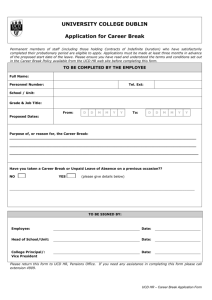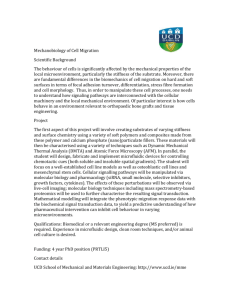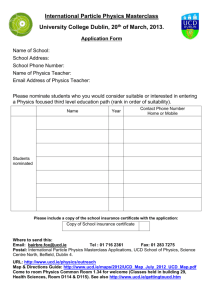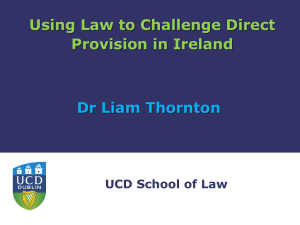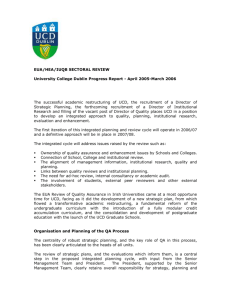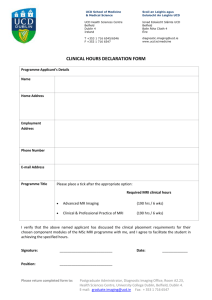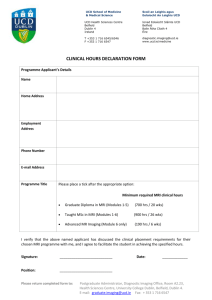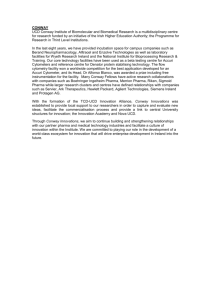William Gallagher & Mairin Rafferty, UCD, OncoMark
advertisement
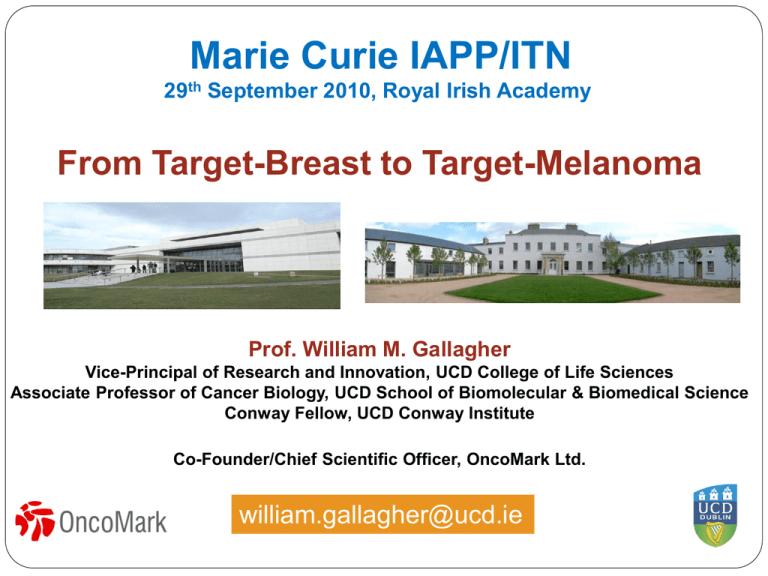
Marie Curie IAPP/ITN 29th September 2010, Royal Irish Academy From Target-Breast to Target-Melanoma Prof. William M. Gallagher Vice-Principal of Research and Innovation, UCD College of Life Sciences Associate Professor of Cancer Biology, UCD School of Biomolecular & Biomedical Science Conway Fellow, UCD Conway Institute Co-Founder/Chief Scientific Officer, OncoMark Ltd. william.gallagher@ucd.ie Tumour Growth and Spread Intravital Microscopy HT1080 fibrosarcoma tumour cells Courtesy of Prof. Robert Hoffman (Anti-Cancer Inc.) Biomarkers in Cancer Management Target-Breast: Marie Curie Industry-Academia Partnership ToK Programme (FP6) 3 academic centres UCD Lund U. NKI 2 industrial partners SlidePath Agendia Focus on converting omic datasets into clinically relevant assays www.targetbreast.com 4 Lessons Learned and Comments - I Programme was of considerable value to consolidate and strengthen pre-existing/new industry-academic interactions Provided great opportunities for advanced training of researchers in different sectors Administration of programme complex, with reporting process difficult in parts (e.g. ambiguous nature of online versus hard copy submissions, EC timeline for sign-off of Annual report – delay of funds) Turnover of contact staff at EC (now REA) appears to be quite high; therefore, difficult to maintain relationship Difficult to recruit good candidates for exchanges: ‘best laid plans!’ Support for proposal preparation was key to drive process (Enterprise Ireland), as well as feedback/advice from Marie Curie/FP contact points (Dagmar Meyer/Caitriona Creely) Useful to complement with other large-scale national (HRB Programme Grant, SFI Cluster Grant) and international (EU IAPP and Collaborative grant) initiatives Need to identify key driver in the process for next initiative Marie Curie Industry Academia Partnership and Pathways Programme (FP7) Why TARGET-MELANOMA? Acronym: Target-Melanoma • One of the fastest rising cancers Title: • Poor prognosis for advanced disease • Current therapeutic strategies modestly successful Molecular Dissection ofofMelanoma • Insight into molecular basis this disease is Progression: lacking Integrated Pan-European Approach Original Partners: 9 partners (4 SMEs, 5 Academics) Current Partners: 7 partners (2 SMEs, 5 academics) Funding: 1.73 M euro An Academic Partners 1. 2. 3. 4. 5. OncoMethylome, Belguim 7. Slidepath, DCU, Ireland 8. Cellix, St.James, Ireland 9. OncoMark, UCD, Ireland 6. SME UCD, Ireland (Coordinator) University of Maastricht, Netherlands University of Leuven, Belgium IDIBELL, Barcelona, Spain: University of Upsalla, HPR, Sweden LEUVEN LEUVEN ER1(18-36) Methylation profiling of Melanoms LEUVEN Time-Line Dec 07 Initial contact with Partners Feb/Mar 08 1st draft & feedback Jan 08 First meeting July 08 Results: On reserve list 2nd Life Sci 3rd overall Mar 25th 08 Submit full application 19 Dec 08 Invitation to negotiate Nov 08 1st Life Sci 2rd overall Feb 09 Negotiate with Commission Jan/Feb 09 Annex1, Gantt Chart & GFPs Aug 09 Start of Project June 09 Grant Agreement Signed Oct 09 Kick Off meeting... Lessons Learned and Comments - II Driver was indeed key; in this case, Dr. Mairin Rafferty (formerly Senior Research Fellow in UCD; now Chief Operations Officer in OncoMark) Need complete buy-in from prospective partners – interactions need to make sense Template information forms can facilitate retrieval of necessary data from prospective partners Preferable to keep number of partners to a modest level for this programme; can be complex to arrange secondments Useful mechanism to progress spin-out activities (e.g. OncoMark) and create new product opportunities Face-to-face meetings, preferably as a group, are highly recommended – people need time to bed down concepts/format of grant Current Activities Dr. Mairin Rafferty R+D Products Target Melanoma Automated Analysis Services Mr. Stephen Penney Dr. Dara FitzGerald
